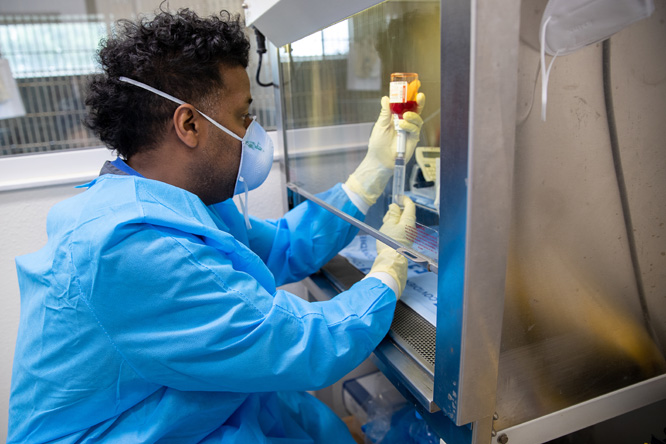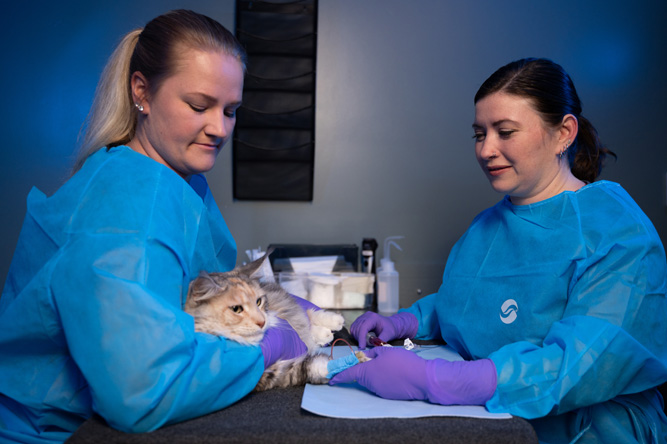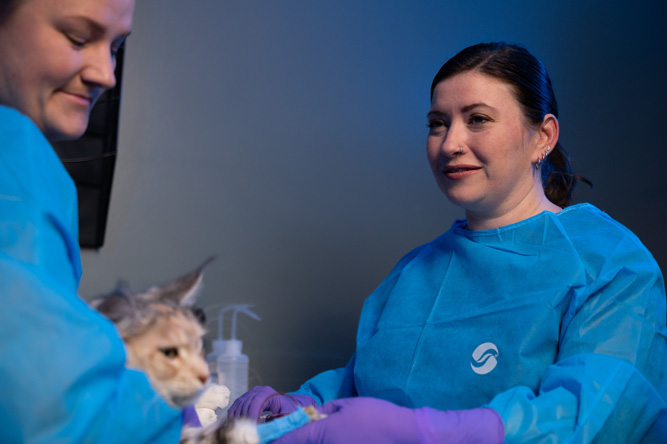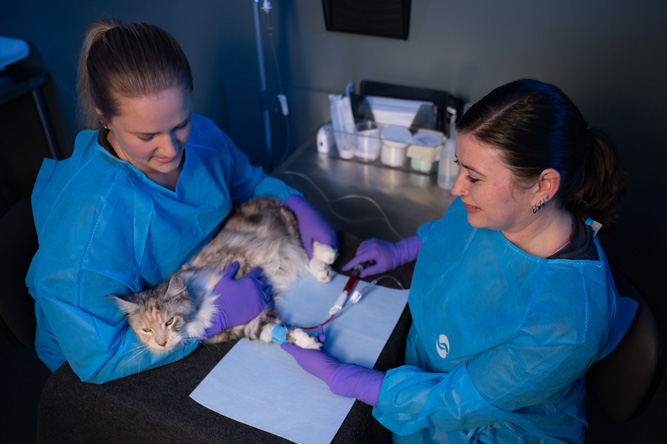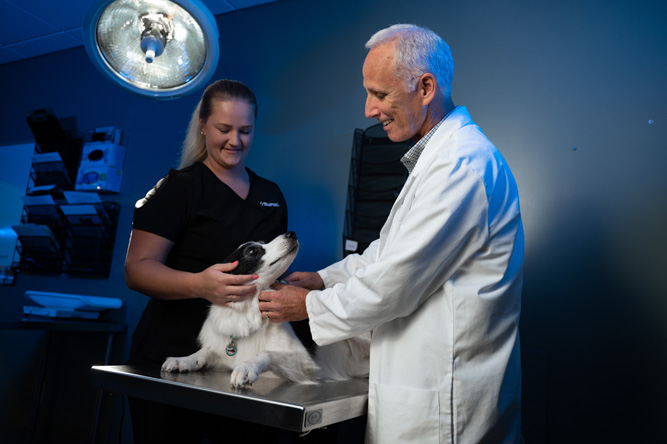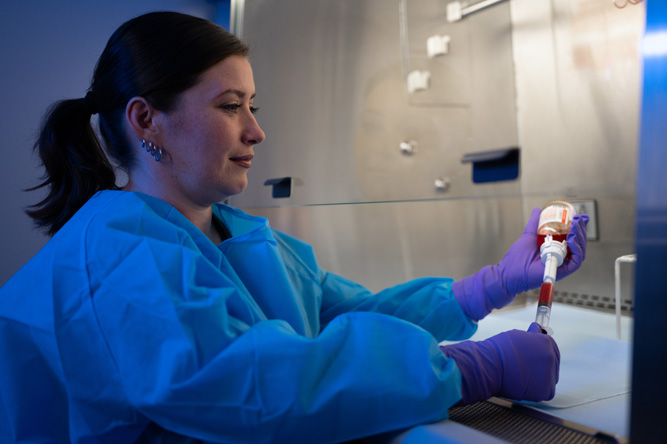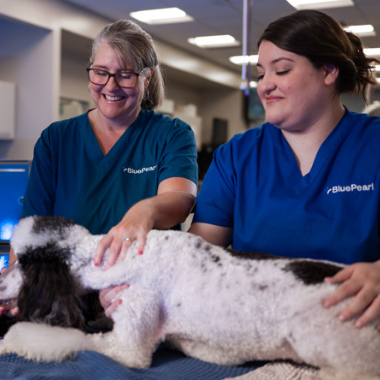Pet oncology by BluePearl.
Advanced cancer care to help your pet live a longer and better life.
We understand that seeing your pet experience unusual symptoms or act out of the ordinary can be stressful – especially if you don’t know what’s wrong. Fortunately, our veterinary oncology team is made up of experts in diagnosing and treating cancer, and we’re here to help.
Our commitment is not just to treat illnesses; it’s to enhance the well-being of your pet and be with you every step of the way.
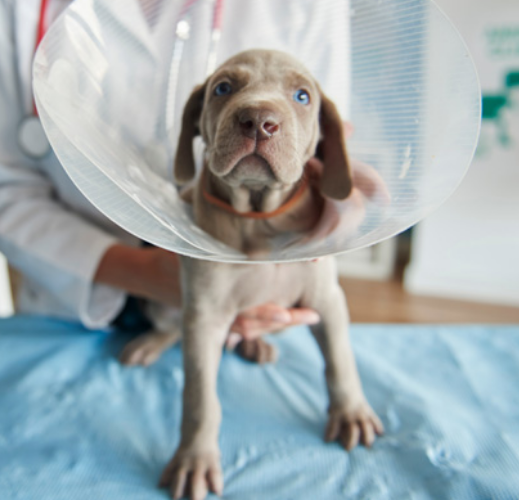
Conditions we treat.
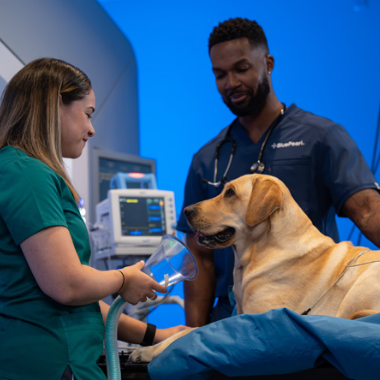
If your pet has cancer, you’ll have an entire oncology team helping to improve your pet’s quality of life so you can get back to what matters most – spending precious moments together.
- Bone cancer
- Liver and spleen cancer
- Lymphatic system cancer
- Mammary (breast) cancer
- Skin cancer
- Soft-tissue cancer
- Thyroid cancer
- Tumors
- Urinary system cancer
Services we offer.
Your pet will receive unparalleled medical care during their time at the hospital (and they’ll be spoiled with love and attention, too).
Advanced diagnostics
Your pet can’t tell us what’s wrong, so we use sophisticated diagnostics and imaging tools to uncover the source of the problem.
- Radiography (x-rays)
- Ultrasound
- Blood testing
- Biopsy
- Cytology
Treatment plans
Just as no two patients are the same, neither are their treatment plans. Our oncology team has experience with a range of advanced procedures and minimally invasive options to get your pet on the path to wellness, including:
- Chemotherapy
- Radiation therapy
- Surgery
Our board certified specialists and oncology team.
Experience makes all the difference.
Our oncology team is made up of veterinarians, vet technicians and assistants, and support staff with rigorous training and experience in specialty medicine. The team works hand in hand to provide the comprehensive, compassionate care your pet needs and deserves. Because we’re a multidisciplinary hospital, the team can consult the expertise of other specialty departments, too.
Rhiannon Doka
DVMDr. Rhiannon Doka provides compassionate and informative care for clients to make the best decisions for their pets’ cancer treatment options. Her goal is to give patients as much quality time as possible doing the things they love.
Dr. Doka’s special interests include comparative oncology, hematopoietic malignancy treatment, clinical trials, targeted cancer therapy and immunotherapy.
- Residency, Medical Oncology, North Carolina State University, Raleigh
- Internship, Medical Oncology, North Carolina State University, Raleigh
- Internship, Small Animal Medicine & Surgery, Veterinary Hospital of the Carolinas, Cary NC
- Clinical Rotation, North Carolina State University, Raleigh
- Doctor of Veterinary Medicine, Ross University, St. Kitts
- Bachelor of Science, Biological Sciences, Barry University, Miami Shores FL
Dr. Doka enjoys spending her free time with family and friends. She has two dogs, Duffy and Taygan, and one cat, Rizzo, that always keep her on her toes.
Karri Miller
DVM, MS, DACVIM (Oncology)Dr. Karri Miller obtained a master’s degree in veterinary science with a focus on oncology and currently collaborates on veterinary oncology projects with NCSU and Sentinel Biomedical. Her clinical interests include lymphoid cancers, cytology and surgical oncology principles.
- Diplomate, American College of Veterinary Internal Medicine (Oncology)
- Residency, Medical Oncology, University of Florida, Gainesville
- Master of Science, Veterinary Science, University of Florida, Gainesville
- Internship, Oncology, Regional Veterinary Referral Center, Springfield VA
- Internship, Small Animal Medicine & Surgery, Texas A&M University, College Station
- Doctor of Veterinary Medicine, University of Florida, Gainesville
- Bachelor of Science, University of Florida, Gainesville
Dr. Miller loves watching sports, especially college football, and supporting her Gators. She also enjoys spending time with her husband and daughter, as well as her three dogs, two Cavaliers and a Dachshund.
David Ruslander
DVM, DACVIM (Oncology), DACVR-RO& Radiation Oncology
Dr. David Ruslander is interested in multimodality management for veterinary oncology patients, meaning treatment that involves surgery, radiation therapy, chemotherapy and/or immunotherapy to achieve the best outcome and quality of life.
- Diplomate, American College of Veterinary Radiology-Radiation Oncology
- Diplomate, American College of Veterinary Internal Medicine (Oncology)
- Residency, Oncology, Tufts University, North Grafton MA
- Internship, Small Animal Medicine & Surgery, University of Saskatchewan, Saskatoon, Canada
- Doctor of Veterinary Medicine, Cornell University, Ithaca NY
- Bachelor of Science, Cornell University, Ithaca NY
Dr. Ruslander enjoys spending time with his wife, three children, two cats, dog and parrot.
Susan Shapiro
PhD, DVM, DACVIM (Oncology)Dr. Susan Shapiro is passionate about delivering personalized medicine and comforting end-of-life care; her favorite part of being a vet is getting to know pets and their families and helping them through difficult times.
Dr. Shapiro’s special interests include urothelial carcinoma in dogs, cancer genetics, cytology and molecular aspects of cancer, particularly how environmental exposures may relate to disease.
- Diplomate, American College of Veterinary Internal Medicine (Oncology)
- Residency, Medical Oncology, North Carolina State University, Raleigh
- Internship, Small Animal Medicine & Surgery, Colorado State University, Fort Collins
- Doctor of Veterinary Medicine, North Carolina State University, Raleigh
- Doctor of Philosophy, Comparative Biomedical Sciences, North Carolina State University, Raleigh
- Bachelor of Science, Biology, University of Virginia, Charlottesville
Dr. Shapiro lives with her husband, son and their dog, a sheltie named Gibita, who happens to be a cancer patient herself. In her free time, Dr. Shapiro enjoys singing, biking, running, international travel, good food and drinks.
Carly Stevens
DVMDr. Carly Stevens has worked in both a cell biology and genetics lab. Her clinical interests include treating histiocytic sarcoma, lymphoma, hemangiosarcoma and tumors.
- Residency, Medical Oncology, North Carolina State University, Raleigh
- Internship, Medical Oncology, North Carolina State University, Raleigh
- Internship, Small Animal Medicine & Surgery, University of Illinois, Urbana-Champaign
- Doctor of Veterinary Medicine, University of California, Davis
- Bachelor of Science, Cell Biology, University of California, Davis
When not working, Dr. Stevens enjoys bicycling, hiking, listening to podcasts, trying new recipes and watching movies. She has a mixed-breed dog adopted in California and named after a local beach.
What to expect.
We want you to be prepared for your pet’s visit to the oncologist, so you have one less thing to worry about. Our entire BluePearl team will be with you every step of the way.
Before your visit
- Make an initial appointment by calling us directly or via referral from your pet’s primary vet.
- We’ll get records from your primary or emergency vet before your first visit and collaborate with them to discuss your pet’s history and current condition.
During your visit
- When possible, we’ll examine your pet with you by their side to make them more comfortable. If additional tests are needed for a diagnosis, we’ll discuss those options with you.
- You’ll have plenty of time and opportunity to ask questions as we go over your pet’s diagnosis together.
- Before you leave, you’ll receive a detailed treatment plan, discharge instructions and any recommended medications. We’ll schedule a recheck appointment and make sure you’re aware of any symptoms you should watch out for at home.
After your visit
- Our team will continue to partner with your primary veterinarian as part of the ongoing management of your pet’s care.
- You know your pet better than anyone, and you play a crucial role in their treatment plan. If you have any concerns about providing care at home (such as giving medication, maintaining a specific diet or monitoring your pet’s symptoms), let us know – we’re here for you.
